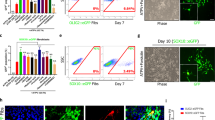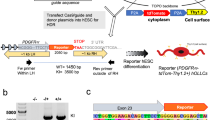Abstract
Myelin-related disorders such as multiple sclerosis and leukodystrophies, for which restoration of oligodendrocyte function would be an effective treatment, are poised to benefit greatly from stem cell biology. Progress in myelin repair has been constrained by difficulties in generating pure populations of oligodendrocyte progenitor cells (OPCs) in sufficient quantities. Pluripotent stem cells theoretically provide an unlimited source of OPCs, but current differentiation strategies are poorly reproducible and generate heterogenous populations of cells. Here we provide a platform for the directed differentiation of pluripotent mouse epiblast stem cells (EpiSCs) through defined developmental transitions into a pure population of highly expandable OPCs in 10 d. These OPCs robustly differentiate into myelinating oligodendrocytes in vitro and in vivo. Our results demonstrate that mouse pluripotent stem cells provide a pure population of myelinogenic oligodendrocytes and offer a tractable platform for defining the molecular regulation of oligodendrocyte development and drug screening.
This is a preview of subscription content, access via your institution
Access options
Subscribe to this journal
Receive 12 print issues and online access
$259.00 per year
only $21.58 per issue
Buy this article
- Purchase on Springer Link
- Instant access to full article PDF
Prices may be subject to local taxes which are calculated during checkout





Similar content being viewed by others
References
Goldman, S.A., Schanz, S. & Windrem, M.S. Stem cell-based strategies for treating pediatric disorders of myelin. Hum. Mol. Genet. 17, R1, R76–R83 (2008).
Watkins, T.A., Emery, B., Mulinyawe, S. & Barres, B.A. Distinct stages of myelination regulated by γ-secretase and astrocytes in a rapidly myelinating CNS coculture system. Neuron 60, 555–569 (2008).
Billon, N., Jolicoeur, C., Ying, Q.L., Smith, A. & Raff, M. Normal timing of oligodendrocyte development from genetically engineered, lineage-selectable mouse ES cells. J. Cell Sci. 115, 3657–3665 (2002).
Brustle, O. et al. Embryonic stem cell-derived glial precursors: a source of myelinating transplants. Science 285, 754–756 (1999).
Hu, B.Y., Du, Z.W. & Zhang, S.C. Differentiation of human oligodendrocytes from pluripotent stem cells. Nat. Protoc. 4, 1614–1622 (2009).
Nistor, G.I., Totoiu, M.O., Haque, N., Carpenter, M.K. & Keirstead, H.S. Human embryonic stem cells differentiate into oligodendrocytes in high purity and myelinate after spinal cord transplantation. Glia 49, 385–396 (2005).
Tam, P.P. & Loebel, D.A. Gene function in mouse embryogenesis: get set for gastrulation. Nat. Rev. Genet. 8, 368–381 (2007).
Tesar, P.J. et al. New cell lines from mouse epiblast share defining features with human embryonic stem cells. Nature 448, 196–199 (2007).
Brons, I.G. et al. Derivation of pluripotent epiblast stem cells from mammalian embryos. Nature 448, 191–195 (2007).
Najm, F.J. et al. Isolation of epiblast stem cells from preimplantation mouse embryos. Cell Stem Cell 8, 318–325 (2011).
Chambers, S.M. et al. Highly efficient neural conversion of human ES and iPS cells by dual inhibition of SMAD signaling. Nat. Biotechnol. 27, 275–280 (2009).
Hemmati-Brivanlou, A. & Melton, D.A. Inhibition of activin receptor signaling promotes neuralization in Xenopus. Cell 77, 273–281 (1994).
Camus, A., Perea-Gomez, A., Moreau, A. & Collignon, J. Absence of Nodal signaling promotes precocious neural differentiation in the mouse embryo. Dev. Biol. 295, 743–755 (2006).
Jessell, T.M. Neuronal specification in the spinal cord: inductive signals and transcriptional codes. Nat. Rev. Genet. 1, 20–29 (2000).
Orentas, D.M. & Miller, R.H. The origin of spinal cord oligodendrocytes is dependent on local influences from the notochord. Dev. Biol. 177, 43–53 (1996).
Trousse, F. et al. Notochord and floor plate stimulate oligodendrocyte differentiation in cultures of the chick dorsal neural tube. J. Neurosci. Res. 41, 552–560 (1995).
Noll, E. & Miller, R.H. Oligodendrocyte precursors originate at the ventral ventricular zone dorsal to the ventral midline region in the embryonic rat spinal cord. Development 118, 563–573 (1993).
Wichterle, H., Lieberam, I., Porter, J.A. & Jessell, T.M. Directed differentiation of embryonic stem cells into motor neurons. Cell 110, 385–397 (2002).
Sun, T. et al. Olig bHLH proteins interact with homeodomain proteins to regulate cell fate acquisition in progenitors of the ventral neural tube. Curr. Biol. 11, 1413–1420 (2001).
Krumlauf, R. et al. Hox homeobox genes and regionalisation of the nervous system. J. Neurobiol. 24, 1328–1340 (1993).
Bogler, O., Wren, D., Barnett, S.C., Land, H. & Noble, M. Cooperation between two growth factors promotes extended self-renewal and inhibits differentiation of oligodendrocyte-type-2 astrocyte (o-2a) progenitor cells. Proc. Natl. Acad. Sci. USA 87, 6368–6372 (1990).
Noble, M., Murray, K., Stroobant, P., Waterfield, M.D. & Riddle, P. Platelet-derived growth factor promotes division and motility and inhibits premature differentiation of the oligodendrocyte/type-2 astrocyte progenitor cell. Nature 333, 560–562 (1988).
Richardson, W.D., Pringle, N.P., Yu, W.P. & Hall, A.C. Origins of spinal cord oligodendrocytes: Possible developmental and evolutionary relationships with motor neurons. Dev. Neurosci. 19, 58–68 (1997).
Cahoy, J.D. et al. A transcriptome database for astrocytes, neurons, and oligodendrocytes: a new resource for understanding brain development and function. J. Neurosci. 28, 264–278 (2008).
Barres, B.A., Lazar, M.A. & Raff, M.C. A novel role for thyroid hormone, glucocorticoids and retinoic acid in timing oligodendrocyte development. Development 120, 1097–1108 (1994).
Chang, A., Nishiyama, A., Peterson, J., Prineas, J. & Trapp, B.D. NG2-positive oligodendrocyte progenitor cells in adult human brain and multiple sclerosis lesions. J. Neurosci. 20, 6404–6412 (2000).
Fancy, S.P. et al. Dysregulation of the Wnt pathway inhibits timely myelination and remyelination in the mammalian CNS. Genes Dev. 23, 1571–1585 (2009).
Hughes, S.M., Lillien, L.E., Raff, M.C., Rohrer, H. & Sendtner, M. Ciliary neurotrophic factor induces type-2 astrocyte differentiation in culture. Nature 335, 70–73 (1988).
Mabie, P.C. et al. Bone morphogenetic proteins induce astroglial differentiation of oligodendroglial-astroglial progenitor cells. J. Neurosci. 17, 4112–4120 (1997).
Windrem, M.S. et al. Neonatal chimerization with human glial progenitor cells can both remyelinate and rescue the otherwise lethally hypomyelinated shiverer mouse. Cell Stem Cell 2, 553–565 (2008).
Chenoweth, J.G. & Tesar, P.J. Isolation and maintenance of mouse epiblast stem cells. Methods Mol. Biol. 636, 25–44 (2010).
Mi, S. et al. Promotion of central nervous system remyelination by induced differentiation of oligodendrocyte precursor cells. Ann. Neurol. 65, 304–315 (2009).
Schug, J. et al. Promoter features related to tissue specificity as measured by shannon entropy. Genome Biol. 6, R33 (2005).
Cheadle, C., Vawter, M.P., Freed, W.J. & Becker, K.G. Analysis of microarray data using Z score transformation. J. Mol. Diagn. 5, 73–81 (2003).
Acknowledgements
This research was supported by funding from US National Institutes of Health (MH087877 and NS30800), Case Western Reserve University School of Medicine, the Myelin Repair Foundation, the New York Stem Cell Foundation (Robertson Investigator award to P.J.T.), and the Cytometry and Imaging Microscopy, the Gene Expression and Genotyping, and the Radiation Resources Core facilities of the Case Comprehensive Cancer Center (P30 CA43703). S.N. was supported by the ENGAGE program of the Center for Stem Cell and Regenerative Medicine. We thank L. Cooperman, M. Hitomi, E. Hitomi, C. Batt, M. Pendergast, K. Wyatt, and members of the P. Scacheri and R. Atit laboratories for technical assistance and I. Tsung for artwork in Supplementary Figure 8, and J. Drazba, J. Peterson and K. Ryan for assistance with live-cell imaging.
Author information
Authors and Affiliations
Contributions
F.J.N. and P.J.T. derived the EpiSC-OPC lines and carried out in vitro experiments; A.V.C., A.Z., F.J.N. and P.J.T. performed in vivo experiments; A.Z., F.J.N., R.H.M. and P.J.T. performed slice culture experiments; E.C.F. carried out the co-culture experiments; F.J.N., S.N. and P.J.T. performed drug screening experiments; F.J.N., P.C.S. and P.J.T. generated and analyzed gene expression data; and F.J.N., R.H.M. and P.J.T. analyzed data and wrote the paper.
Corresponding author
Ethics declarations
Competing interests
The authors declare no competing financial interests.
Supplementary information
Supplementary Text and Figures
Supplementary Figures 1–8, Supplementary Tables 1–2 (PDF 9057 kb)
Supplementary Video 1
Time-lapse imaging of EpiSC-derived OPCs differentiated to oligodendrocytes. Images were collected every 10 min for 68 h on an inverted microscope outfitted with a precision scanning stage in a live cell incubation chamber and cover at 37 °C and 5% CO2 in medium containing T3, SHH, noggin, cAMP, IGF1 and NT3. (MOV 8743 kb)
Rights and permissions
About this article
Cite this article
Najm, F., Zaremba, A., Caprariello, A. et al. Rapid and robust generation of functional oligodendrocyte progenitor cells from epiblast stem cells. Nat Methods 8, 957–962 (2011). https://doi.org/10.1038/nmeth.1712
Received:
Accepted:
Published:
Issue Date:
DOI: https://doi.org/10.1038/nmeth.1712
This article is cited by
-
Oligodendrocyte differentiation alters tRNA modifications and codon optimality-mediated mRNA decay
Nature Communications (2022)
-
Suppression of proteolipid protein rescues Pelizaeus–Merzbacher disease
Nature (2020)
-
Accumulation of 8,9-unsaturated sterols drives oligodendrocyte formation and remyelination
Nature (2018)
-
Induction of myelinating oligodendrocytes in human cortical spheroids
Nature Methods (2018)
-
Rapid functional genetics of the oligodendrocyte lineage using pluripotent stem cells
Nature Communications (2018)



